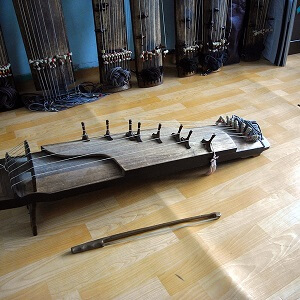Ajaeng
 Ajaeng, large Korean bowed zither having seven strings. Its body is about 160 cm (62 inches) long and 25 cm (10 inches) wide and is made of paulownia wood. The ajaeng’s strings, made of twisted silk, are supported by separate movable bridges. The bow with which it is played, some 65 cm (25 inches) long, is fashioned from a peeled forsythia branch that has been hardened with pine resin.
Ajaeng, large Korean bowed zither having seven strings. Its body is about 160 cm (62 inches) long and 25 cm (10 inches) wide and is made of paulownia wood. The ajaeng’s strings, made of twisted silk, are supported by separate movable bridges. The bow with which it is played, some 65 cm (25 inches) long, is fashioned from a peeled forsythia branch that has been hardened with pine resin.
The instrument, which is placed in a transverse position on the floor, is supported on its bowed end by a stand. The player sits on the floor behind it and moves the bow over the strings to the right of the bridges while the left hand varies pitch and vibrato by pressing the strings on the other side of the bridges. Characteristically the tone of the ajaeng is raspy, and its melodies are highly inflected and expressive.
A long half-tube zither with a hollow wooden body and sounded with a resined bow. Approximately 1/5th of the body is at an obtuse angle to the rest of the body. It has flat sides and undersurface of light coarse-grained wood.
Seven tight-wound silk strings run parallel along the length of the body, attached at the angled end by thick dark-blue cords. The strings are stretched over seven separate moveable wooden bridges, linked to each other by a think dark-blue cotton string. The angled end rests on the floor, the long end rests on a collapsible wooden frame of dark-stained color.
It is used in court music in tangak, hyangak, and chongmyoak ensemble, as well as in Shinawi instrumental ensemble music originally accompanying shaman rituals. This instruments appears to be in fairly good condition except for two small hairline cracks on the underbelly beside the small soundhole.